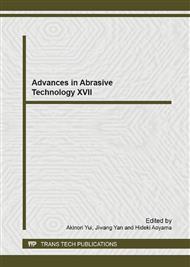p.406
p.411
p.417
p.423
p.429
p.435
p.441
p.447
p.452
Long-Duration Frictional and Wear Performance of the Diamond/DLC Bilayered Film under Water-Lubricating Condition
Abstract:
In the present study, the long-duration frictional and wear performance of the MCD/DLC (Micro-crystalline Diamond / Diamond-like Carbon) bilayered film are investigated under water-lubricating conditions. All friction tests are carried out on a rotation “ball-on-plate” tribotester where the MCD/DLC is slid against with a Φ 6.0 mm Si3N4 ball and the whole sliding contact is immersed in deionized water during the sliding process. A full factorial experimental plan is conducted with four sliding velocities ranging from 0.126 to 0.503 m/s and four normal loads from 2 to 8 N. The duration of each sliding process is 24 h. For the sake of comparability, conventional MCD and NCD (nanocrystalline Diamond) films are also adopted under each sliding condition. The results show that the stable coefficient of friction (COF) of MCD/DLC film is ranging from 0.025 to 0.12 under the water-lubricating condition, comparable with the NCD film but much lower than that of single-layered MCD film; in contrast, the top-layered DLC film does not show beneficial effect on enhancing the sliding stability of single-layered diamond films. Moreover, its specific wear rate is estimated at the level of 10-8 mm3N-1m-1, higher than that of MCD or NCD films. The sliding interface is under boundary lubrication condition, high normal load causes more prominent mechanical interactions between two contacted surfaces and thus produces a smoother and cleaner equilibrium sliding interface, which finally results in the decreasing tendency of stable COF as the load rises. Comparatively, the sliding velocity does not exhibit evident influence on the stable COF of the MCD/DLC film.
Info:
Periodical:
Pages:
429-434
Citation:
Online since:
September 2014
Authors:
Price:
Сopyright:
© 2014 Trans Tech Publications Ltd. All Rights Reserved
Share:
Citation:


